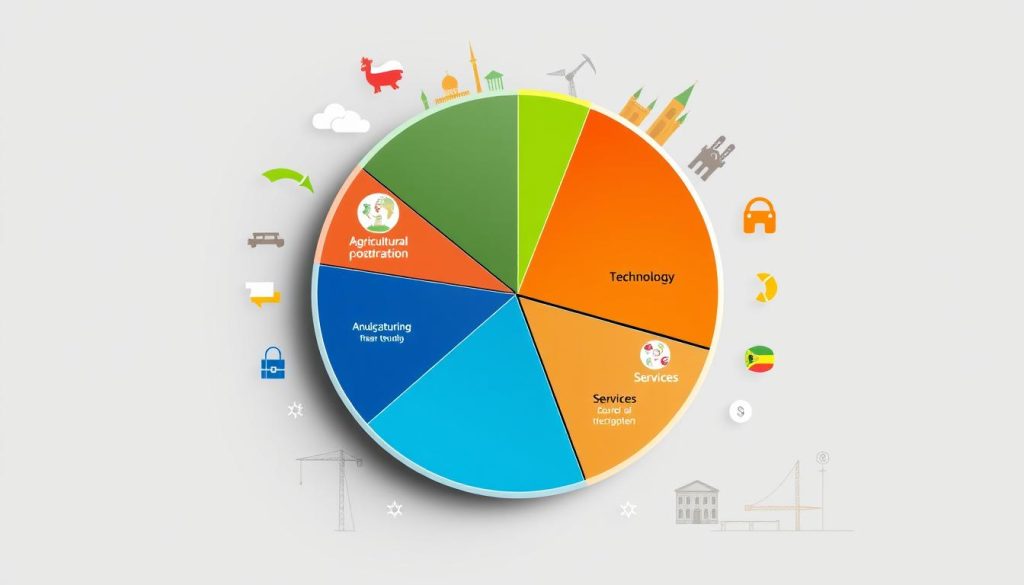In 2022, Poland saw big changes in its business statistics. Statistics Poland reported that businesses made 8,233.4 billion PLN in sales. This was a 25.4% jump from the year before.
This growth shows how important Poland’s business data is. It plays a key role in the European economy.
The number of active businesses in Poland went up by 0.4%. This means there were 2,675.9 thousand businesses. The service sector was especially strong, growing by 3.4%.
But, trading activities took a hit, falling by 2.9%. This was mainly in sectors like trade and car repairs.
Overview of Structural Business Statistics
Understanding structural business statistics is key to grasping the complex world of economic activities in the EU, especially in Poland. These statistics give us a detailed look at how businesses operate, their structures, and how well they perform. They help us make better business decisions and see how they affect different areas.
Definition and Importance
Structural business statistics cover a lot of data about businesses. This includes their size, the sector they’re in, and how well they do. In 2022, services made up 18.1% of EU businesses, and professional and technical activities were 15.6%. These statistics are crucial for understanding the business world.
Purpose of Structural Business Statistics in Economic Analysis
We use these statistics to see how different sectors affect the economy and track changes over time. They help us look at jobs, value created, and how sectors contribute to the economy. For instance, in 2022, EU manufacturing added about €2,420 billion to the economy. This shows the big role some sectors play in the economy’s health.
Key Findings from 2022
The economic scene in Poland in 2022 saw important changes, especially in turnover and business activity. Our study uncovered key trends that show how businesses grew. These findings are crucial for understanding the country’s economic health.
Turnover Increase in Enterprises
In 2022, Polish businesses achieved great financial success. The turnover growth hit 8,233.4 billion PLN, a 25.4% jump from the year before. This shows how well Polish businesses are doing, playing a big part in the country’s economy.
These statistics highlight a strong business environment. Businesses in Poland are overcoming economic hurdles, growing their operations.
Change in Number of Active Enterprises
The number of active businesses in Poland went up slightly, reaching 2,675.9 thousand units. This is a 0.4% increase from the previous year. The services sector led this growth, with a 3.4% rise in business numbers.
This shift towards service-based businesses is notable. While trade saw a 2.9% drop, other sectors are growing. This shows Polish businesses are adapting well to economic changes.

Sectoral Contributions to Business Activity
Poland’s business economy is changing, with different sectors playing key roles. Services growth is a big driver of the economy. The professional, scientific, and technical services sector is leading this growth.
However, trade activity is declining. This has raised concerns about the future of traditional sectors.
Growth in the Services Sector
The services sector in Poland is growing fast. It’s a big part of our economy, with more businesses and jobs. In 2021, it had 11.6 million people working and added €681.8 billion to the economy.
This sector makes up about 15.5% of all businesses. It’s crucial for our economy.
Declines in Trade and Other Activities
Trade activities, like car repairs, have seen a 2.9% drop. This decline worries about the economy’s future. It shows how important it is for trade to adapt to changes.

Employment Trends within Poland’s Business Economy
In 2022, Poland’s employment saw a 1.1% growth, with a total workforce of 11,511.3 thousand. This shows a positive change, especially in the service sector, which grew by 2.7%. Other sectors also saw a 3.5% increase, showing a rising demand for jobs.
Understanding these trends is key to our economic stability and job creation. It helps us navigate our business landscape better.
Employment Growth Rates in 2022
The employment growth in 2022 was strong compared to past years. The employment rate for those aged 20-64 hit 76.7%, beating the EU average of 74.6%. This success shows our policies support workforce participation well.
However, we face a challenge with a projected 800,000 fewer workers by 2030. Meeting this challenge is crucial for Poland’s economic growth and workforce vitality.
Sector-wise Employment Distribution
The employment distribution across sectors shows interesting trends in Poland’s economy. The service sector is thriving, but we must note regional and industry-specific challenges. For example, 72% of construction employers and 67% in manufacturing face labour shortages.
Despite these challenges, Poland’s unemployment rate is 3.0% as of April. This puts us in a good position in the EU. As we move forward, targeted efforts are needed to boost job creation, training, and workforce participation. This will help our economy stay strong.

